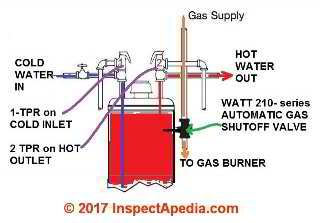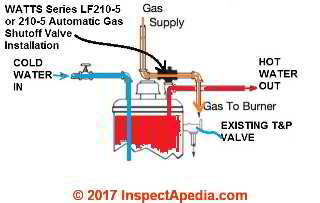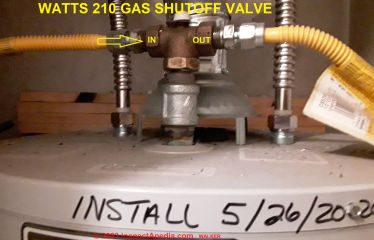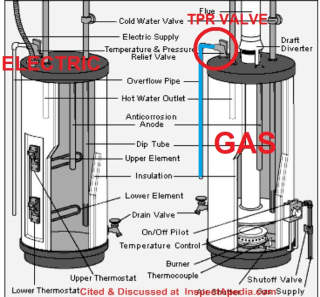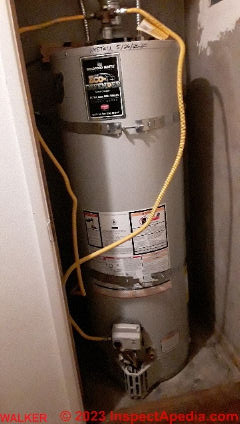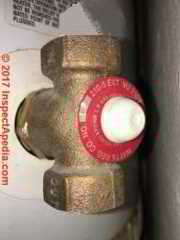 Automatic Gas Water Heater Shutoff Valves
Automatic Gas Water Heater Shutoff Valves
Watts 210 automatic gas shutoff valve use on water heaters
- POST a QUESTION or COMMENT about LP or natural gas shutoff valve: installation, location, leaks, testing & use
Automatic LP, Propane or Natural Gas Shutoff Controls & Valves for water heater:
This article series describes the installation, function, & safety of automatic gas line shutoff valves used on water heaters, such as the Watts 210-5 series automatic gas shutoffs. Water temperature that is unsafe turns off the gas supply to the gas burner.
Our page top photo shows a Watts series 210-5 automatic gas shutoff valve installed in the TPR valve tapping on the side of a gas-fired water heater. The gas piping that is to run into and out of this valve has not yet been installed.
InspectAPedia tolerates no conflicts of interest. We have no relationship with advertisers, products, or services discussed at this website.
- Daniel Friedman, Publisher/Editor/Author - See WHO ARE WE?
How & Where Locate & Inspect Natural Gas or LP Gas Fuel Shutoff Valves
Automatic Gas Shutoff Valves on Water Heaters

Shown at page top and again here is a Watts 210-5 automatic gas shutoff valve installed at the temperature-pressure relief valve on a gas fired residential water heater.
The gas piping had been removed when this picture was taken by our reader (Anon) in 2017 .
Gas supply piping in a completed installation is passed through the Watts 201-5 and onwards to the water heater's own gas controls and burner as we will illustrate in sketches below.
This automatic gas shutoff valve for water heaters may be installed in three situations:
- Install the automatic gas shutoff in the water heater's TPR valve tank side or tank top tapping.
The Watts 210-5 Shutoff may be installed right into the Temperature-Pressure-Relief valve tapping on the side of a water heater if the heater was not provided with a conventional temperature/pressure relief valve already installed in that location.
See RELIEF VALVE, WATER HEATER for details about conventional TPR valves on water heaters.
(Sketch below, adapted from Watts 210-5 regulator installation instructions cited below)
[Click to enlarge any image]
Watch out: in our OPINION, though you may find older water heaters in this configuration, water heaters with a remote TP valve - that is a TPR valve connected to cold water inlet (1 in the sketch) or possibly to hot water outlet piping (2) - are less safe than those with a TPR valve in the factory-designated tank side or top tapping intended for a relief valve. But in all of these installations adding the Watts 210-5 will increase the safety of the water heater.
Watts Regulator's installation instructions include this safety warning:
A pressure relief valve must be installed as shown to prevent excess pressure by thermal expansion.
There must be no valve between the relief valve and heater. Relief valve must be piped to a suitable drain.
Relief valve must be located in an area that is not subject to freezing. Removal of the factory installed T&P valve may void water heater manufacturer’s warranty.
- The Watts 210-5 may be installed into the top of a tee in the hot water outlet piping at the top of a water heater
if the heater already has a conventional TPR valve installed on the water heater at its side tapping. The probe of the gas shutoff valve will pass down through the tee into the top of the water heater. (Sketch below)
- The Watts 201-5 may also be installed into the side tapping on a water heater tank
(intended for a conventional relief valve) if instead of a conventional TPR valve the water heater uses a "remote" relief valve on the hot water piping above the heater. This installation is shown in our page-top photos.
Functioning similarly to a water heater "TPR" or "temperature-pressure-relief valve this control will respond to an unsafe, too-hot water temperature by shutting off the gas supply to the water heater.
The Watts 201-5 valve shown will shut off the gas supply if water temperature exceeds 210°F. The valve uses a "snap action latch" to secure the gas supply in the OFF position. The white button at th valve top is a manual reset that must be operated if this valve has shut off the gas supply.
Our second image of the Watts 210-5 automatic gas shutoff valve just below, adapted from Watts literature, shows the key components of this control.
Here is Watts Regulator Corporation's description of their 210-5 Series water heater gas line safety control:
Series 210-5 Automatic Gas Shutoff Valves are used in gas water heater applications to protect against overheating water in the domestic hot water supply heating system. It is an immersion-type valve that automatically shuts off the gas supply to the heater if the temperature reaches 210°F (99°C).
It is a self-contained device that consists of Buna-N disc-to-metal seating, manual reset button to reopen the valve after an automatic shutoff, trip latch assembly and stainless steel spring seats to close the valve at a controlled temperature, and thermostat with extension tube which operates trip latch in response to water temperature.
Design certified by CSA. Models L210-5 M2, LL210-5 M2 and LLL210-5 M2 feature extended shanks for use with water heaters containing extra thick insulation, up to 3 in. - Watts Corporation cited below.
Watts 210 Automatic Gas Shutoff Valve Approvals, Codes, Installation Manuals
This valve is sold in various models with temperature probes of varying lengths to accommodate water heaters with various thicknesses of insulation:
- Contact: Watts Regulator Corporation, USA: 815 Chestnut St., No. Andover, MA 01845-6098; www.wattsreg.com
Canada: 5435 North Service Rd., Burlington, ONT. L7L 5H7; www.wattscanada.ca
Contact your local Watts representative: https://www.watts.com/how-to-buy-sales-representative - 210-5 M2 Suitable for water heaters with up to 3/4" of insulation
- L210-5 M2 Suitable for water heaters with up to 2" of insulation
- LL210-5 M2 Suitable for water heaters with up to 21/2" of insulation
- Watts 210 AUTOMATIC GAS SHUTOFF VALVE INSTALLATION INSTRUCTIONS [PDF] (2014) Watts, op. cit. original source: http://media.wattswater.com/1910217.pdf
- Watts 210-5 AUTOMATIC GAS SHUTOFF VALVE SPECIFICATION product description, [PDF] (2005) Op. Cit., retrieved 2017/05/17, original source: http://www.watts.com/pages/_products_details.asp?pid=3435
...
Reader Comments, Questions & Answers About The Article Above
Below you will find questions and answers previously posted on this page at its page bottom reader comment box.
Reader Q&A - also see RECOMMENDED ARTICLES & FAQs
2023/05/26 - HUD inspector failed water heater with Watts 210-5 Shutoff Installed
I posted a comment on your website before I saw that I could contact you via email. I would really appreciate any help that you could give us in this situation! Please see attached HUD Diagram and photos of our water heater in it's current state.
A Watts 210 automatic gas shutoff valve was installed at the same time that we had a new water heater installed in our HUD rental house on 5/26/2020. Since the time of its installation, we have passed the Annual HUD Inspection every year, but this year for the first time a new (HUD)Inspection company failed our rent.
Our plumber said that the Watts 210 is an immersion-type valve used to protect against overheating water in a water heater.
The valve is installed where the T&P would normally be installed on a water heater, and it has a thermostat that goes inside the water heater. The gas line is run into the Watts 210 from the gas source and then run from the Watts 210 to the gas control on the water heater
The Watts 210 automatic gas shutoff valve is typically used if the T&P line cannot be run to the exterior of the residence as required by many state plumbing codes, especially in California. Plumbers use this when the water heater is located in an inside closet such as in a hallway (as our water heater is) or the kitchen. In our rental houses’ case, a Watts 210 automatic gas shutoff valve was recommended.
The question is: Can a Watts 210 automatic gas shutoff valve be used as an alternative (replacement) for the relief valve discharge piping that is required by HUD?
And can you please give us a step-by-step guide to properly converting the Watts 210 valve to the T&P relief valve discharge piping, so that my plumber can correctly install it and be up to code before the re-inspection?
HUD isn't giving us any answers, nor the 3rd party inspection company, that is why we are reaching out for assistance. - Anonymous by private email.
Moderator reply: check & provide the Watts 210 gas shutoff valve installation instructions to your inspector, also check with Watts re HUD approval
I've just returned from out-of-contact travels and need time read this question again with care and to do a bit more research into the HUD position. It'd help to know where you posted the question online.
In general, the Watts 210 is indeed used as an alternative to a conventional TP valve - a more-costly solution that works for cases where it's not easy to pipe the conventional relief valve to the building exterior.
We describe the proper and approved use of the Watts 210 above on this page.
My first recommendation is that you get a copy of the installation instructions for the Watts 210 gas shutoff, compare those with your installation, confirm that it complies with the manufacturer's instructions, then show that to your HUD inspector.
See Watts 210 AUTOMATIC GAS SHUTOFF VALVE INSTALLATION INSTRUCTIONS [PDF] Watts, Op.Cit.
Typical building codes require that devices be "installed following the manufacturer's instructions". That should be sufficient.
Second, you might want to contact Watts to ask their technical support the specific question: is this valve permitted in HUD approved housing installations of gas water heaters?
This page - watts.com/how-to-buy-sales-representative will get you contact information for a Watts representative who covers the area where you live. If you take this route please let us know what you're told as that will be very important for other people in the same situation as you.
If there is still an issue, Watts Corporation Rep may be able to provide you with documentation that satisfies your HUD inspector, as indeed you can read in my notes below, a simple read of the existing HUD regulations don't appear include a reference to this alternative water heater safety control.
Watts lists the approvals of this device at their web page watts.com/products/plumbing-flow-control-solutions/water-heater-accessories/shutoff-valves/210-5 - you won't find "HUD" listed there.
It would be useful to see the HUD inspector's report. I'm also asking our own HUD inspection expert for help with this question, so as to determine if we've simply run into a case where the HUD inspector does not know this safety device or if instead s/he knows something that we don't.
You might consider simply adding an acceptable relief valve if your inspector and heater permit that. " The Watts 210 can be used in conjunction with Model 3L pressure relief valve, p.20" - source: Water Heater Safety, Watts: media.wattswater.com/C-WR.pdf
If you are simply going to remove & replace the Watts 210 with a conventional T&P valve (unfortunate) your plumber will remove the existing Watts 210, route the gas line directly to the gas control valve on the water heater, and install a conventional T&P valve to meet code.
That means that - depending on your local code authority - if the discharge of the replacement valve is routed to the building exterior it should be visible, AND inside a Tundish is installed so that the homeowner/occupant can SEE that the TP valve is leaking or discharging.
The Tundish device is described at
TUNDISH used in PLUMBING
The IO manual for the Watts 210 that you have installed is at
https://inspectapedia.com/plumbing/Watts-210-5-Gas-Shutoff-Installation-Manual.pdf
HUD Regulations for Water Heater Relief Valves
Below is an excerpt from HUD regulations for water heater relief valves - original source: https://www.ecfr.gov/current/title-24/subtitle-B/chapter-XX/part-3280
...
Water heater safety devices —
(c)(1)
(1) Relief valves.
(c)(1)(i)
(i) All water heaters shall be installed with approved and listed fully automatic valve or valves designed to provide temperature and pressure relief.
(c)(1)(ii)
(ii) Any temperature relief valve or combined pressure and temperature relief valve installed for this purpose shall have the temperature sensing element immersed in the hottest water within the upper 6 inches of the tank. It shall be set to start relieving at a pressure of 150 psi or the rated working pressure of the tank whichever is lower and at or below a water temperature of 210 °F.
(c)(1)(iii)
(iii) Relief valves must be provided with full-sized drains, with cross sectional areas equivalent to that of the relief valve outlet. The outlet of a pressure relief valve, temperature relief valve, or combination thereof, must not be directly connected to the drainage system.
The discharge from the relief valve must be piped full size separately to the exterior of the manufactured home, not underneath the home, or to an indirect waste receptor located inside the manufactured home.
Exterior relief drains shall be directed down and shall terminate between 6″ and 24″ above finished grade. Drain lines must be of a material listed for hot water distribution and must drain fully by gravity, must not be trapped, and must not have their outlets threaded, and the end of the drain must be visible for inspection.
(c)(1)(iv)
(iv) Relief valve piping designed to be located underneath the manufactured home is not required to be installed at the factory provided the manufacturer designs the system for site assembly and also provides all materials and components including piping, fittings, cement, supports, and instructions for proper site installation.
...
(h) A corrosion resistant water drip collection and drain pan must be installed under each water heater that will allow water leaking from the water heater to drain to the exterior of the manufactured home, or to a drain.
Continuing:
Building & HUD codes both specify that a water heater (and a safety device such as the Watts 210) "shall be installed in accordance with the manufacturer's instructions." I can't see in your photos the exact model of your Bradford White EcoDefender gas fueled water heater, and cannot see if the heater already includes a side-tapping for a separate temperature-pressure relief valve.
If so, your inspector ought to be satisfied with minimum argument if you simply add a TPR valve there. (Watts literature does expect there to be other pressure relief devices in the water system.)
Alternatively you can show your HUD inspector the Watts 210 Instructions - she can then see that your heater is "installed according to the manufacturer's instructions" for it's bound to be one of the two cases shown in the illustration we provided above, excerpted from the Watts 210 IO manuals that I gave to you earlier.
Fig. 1 shows the Watts Series LF210-5 or 210-5 installed on the water heater's hot water outlet tapping atop a tee, and a separate factory-installed T&P relief valve on the side of the water heater.
Fig. 2 shows the Watts LF210-5 or 210-5 automatic gas shutoff installed on the side-tapping of the water heater for the case of heaters that were not delivered with a factory-installed T&P valve already installed.
Your water heater does not match either of these exactly as your Watts 210-5 is installed in a center top tapping on your water heater where, most-likely, there was either a plug or a factory-installed T&P valve when the heater was delivered.
In that setup it looks as if your heater installation is a Fig.2. case. (Is there a side tapping and /or T&P valve on your heater now or not?)
Reader follow-up:
Thank you so much for replying to my water heater issue!! I found the manufacturer's instructions right after I emailed you and I sent it in an email to the HUD Inspectors and they said that the water heater PASSED!
Thank you again for all of your efforts!! I was in a bind and really needed some answers and you came through like a champ!
On 2019-12-09 y danjoefriedman (mod) - this Watts 210-5 safety valve is approved by any city
Carlos
If that was a question, you can see the certifications on these gas shutoff valves by clicking on the links to the various instructions given as PDF files near the end of the article above.
On 2019-12-08 by carlos
this safety valve is approved by any city
On 2018-04-09 by danjoefriedman (mod)
Lavern
Thank you for posting your opinion - I agree with you completely.
On 2018-04-09 by Lavern Burk
@Juan e.,
If the gas control on the water heater doesn't shut-off and overheats the water this valve will shut the gas off to the gas control.
On 2018-04-09 by Lavern Burk - TPR valves on the cold water inlet line are less safe
"Watch out: in our OPINION, though you may find older water heaters in this configuration, water heaters with a remote TP valve - that is a TPR valve connected to cold water inlet (1 in the sketch) or possibly to hot water outlet piping (2) - are less safe than those with a TPR valve in the factory-designated tank side or top tapping intended for a relief valve.
But in all of these installations adding the Watts 210-5 will increase the safety of the water heater."
The only time this valve is used "usually" is when there is no way to run a proper drain to a receptor or the outside and a standard temperature and pressure relief valve. You do not install this valve in conjunction with the standard T&P valve.
The pressure relief is done by installing a pressure relief valve at the main water service entry outside. This is acceptable in both the Uniform and International Plumbing Codes.
On 2017-12-10 by Juan e.
Why this valve goes off
...
Continue reading at RELIEF VALVE, WATER HEATER - topic home, or select a topic from the closely-related articles below, or see the complete ARTICLE INDEX.
Or see these
Recommended Articles
- GAS SHUTOFF VALVES, LP or NATURAL including fire safety valves that shut off gas supply to a heating appliance or water heater
- GAS LINE FIRE SAFETY VALVES
- RELIEF VALVES - TP VALVES
- WATER HEATER SAFETY for our complete list of water heater safety devices and water heater safety inspection advice.
Suggested citation for this web page
GAS WATER HEATER AUTOMATIC SHUTOFF at InspectApedia.com - online encyclopedia of building & environmental inspection, testing, diagnosis, repair, & problem prevention advice.
Or see this
INDEX to RELATED ARTICLES: ARTICLE INDEX to GAS APPLIANCES, PIPING, CONTROLS
Or use the SEARCH BOX found below to Ask a Question or Search InspectApedia
Ask a Question or Search InspectApedia
Try the search box just below, or if you prefer, post a question or comment in the Comments box below and we will respond promptly.
Search the InspectApedia website
Note: appearance of your Comment below may be delayed: if your comment contains an image, photograph, web link, or text that looks to the software as if it might be a web link, your posting will appear after it has been approved by a moderator. Apologies for the delay.
Only one image can be added per comment but you can post as many comments, and therefore images, as you like.
You will not receive a notification when a response to your question has been posted.
Please bookmark this page to make it easy for you to check back for our response.
IF above you see "Comment Form is loading comments..." then COMMENT BOX - countable.ca / bawkbox.com IS NOT WORKING.
In any case you are welcome to send an email directly to us at InspectApedia.com at editor@inspectApedia.com
We'll reply to you directly. Please help us help you by noting, in your email, the URL of the InspectApedia page where you wanted to comment.
Citations & References
In addition to any citations in the article above, a full list is available on request.
- Preferred Utilities Manufacturing Corp., 1-35 South St, Danbury, CT 06810, United States Tel: 203.743.6741, website: www.house-whisperer.com, Danbury CT.
- Emerson Process Management, Website: http://www2.emersonprocess.com, Email: InfoCentral@EmersonProcess.com, provides Fisher Liquid Propane / LP-Gas valves provide shutoff, excess flow and back check functions and are used in bulk plants, bulk transports, bobtails, and in in-line installations.
- RegO® Products, USA, 100 RegO Drive
Elon, NC 27244 USA
Email: ecii@regoproducts.com,
Rego Europe Industries 9 35075 Gladenbach, Germany Email: info@rego-europe.de, Phone: 0049 6462 9147 10
Latin America, RegO S. DE R.L. DE C.V. Ave Apolo #504 Parque Industrial Kalos Del Poniente Santa Catarina, N.L. C.P 66370 Email: pechever@regoproducts.com.mx, Tel: 52 (81) 8032-5250
Rego Asia, SectionD, Floor 4, Building #15, 69 Xiya Rd, Shanghai Waigaoqiao Free Trade Zone Shanghai, China 200131 Email: Ming Jin ming@rego-asia.com, Tel: +21 504 62-183, 504 62-012 - Robertshaw Gas Valves, Robertshaw Controls Co, Invensys Controls, 191 E. North Avenue Carol Stream Illinois 60188 USA Customer Service Telephone 1.800.304.6563 Email: HVACCustomerService@Invensys.com
- National Fuel Gas Code, ANSI Z223.1-yyyy - American Gas Association / National Fire Protection Association
- LP-Gas Serviceman's Handbook,Fisher-Rosemount, Fisher Controls
- Specifications for Gas Installations, Central Hudson Gas and Electric Corporation
- "Gaslight", Gary Quilliam, The Old House Journal, March/April 1989 article describes fixtures, modern fixtures, and sources of supply.
- Carbon Monoxide Gas Toxicity, exposure limits, poisoning symptoms, and inspecting buildings for CO hazards
- HOT WATER HEATERS - a detailed guide to all types of hot water sources, problems, inspection, repair
- In addition to citations & references found in this article, see the research citations given at the end of the related articles found at our suggested
CONTINUE READING or RECOMMENDED ARTICLES.
- Carson, Dunlop & Associates Ltd., 120 Carlton Street Suite 407, Toronto ON M5A 4K2. Tel: (416) 964-9415 1-800-268-7070 Email: info@carsondunlop.com. Alan Carson is a past president of ASHI, the American Society of Home Inspectors.
Thanks to Alan Carson and Bob Dunlop, for permission for InspectAPedia to use text excerpts from The HOME REFERENCE BOOK - the Encyclopedia of Homes and to use illustrations from The ILLUSTRATED HOME .
Carson Dunlop Associates provides extensive home inspection education and report writing material. In gratitude we provide links to tsome Carson Dunlop Associates products and services.


